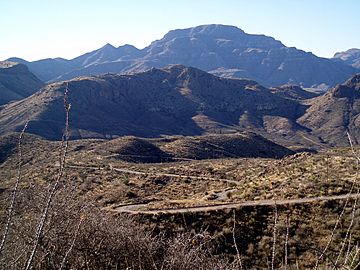Chinati Mountains facts for kids
Quick facts for kids Chinati Mountains |
|
|---|---|

Pinto Canyon Road in the Chinati Mountains
|
|
| Highest point | |
| Peak | Chinati Peak |
| Elevation | 7,728 ft (2,355 m) |
| Geography | |
| Country | United States |
| State | Texas |
| Geology | |
| Type of rock | Igneous |
The Chinati Mountains are a small mountain range in West Texas, near the city of Presidio. They are part of the high desert landscape. A road called Pinto Canyon Road goes through these mountains. Some people think the name "Chinati" comes from an Apache word meaning "gate" or "mountain pass."
Contents
Exploring the Chinati Mountains
What are the Chinati Mountains Made Of?
These mountains are mostly made of special rocks called igneous and metamorphic rocks. Scientists believe they were formed long ago by powerful volcanic eruptions. These eruptions created large, bowl-shaped hollows called calderas.
The Chinati Mountains are not covered in forests. Instead, you will find grasses, cactus, and brush. This type of plant life is common in the Chihuahuan Desert, where the mountains are located.
A History of Silver Mining
From the 1860s to the 1910s, people mined a lot of silver in the Chinati Mountains. This was an important activity in the area for many years.
What is the Highest Point in the Chinati Mountains?
The tallest point in the range is Chinati Peak. It stands at 7,728 feet (2,355 m) high. Chinati Peak is also the highest point in Presidio County.
Seeing Chinati Peak from Afar
Chinati Peak is a major landmark for the area. Its round, dome-shaped top can be seen far away. If you are on US 90 between Van Horn and Marfa, you can spot it rising in the distance to the southwest.
The peak is surrounded by sharp desert peaks and deep, rugged canyons. The very top of Chinati Peak is wide and fairly flat. However, it is surrounded by steep cliffs and rocky areas filled with brush. Sierra Parda is the second-highest peak in the range, reaching 7,185 feet (2,190 m).
Chinati Mountains State Park
The Chinati Mountains State Park covers about 40,000 acres of the mountain range. It is the second-largest state park in Texas. For a long time, it was very hard for the public to visit this park. However, Texas Parks and Wildlife announced in October 2014 that public access to the park has finally been made possible.

